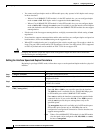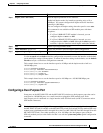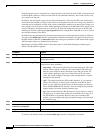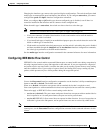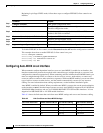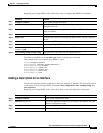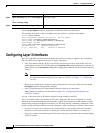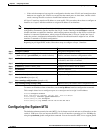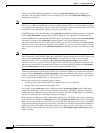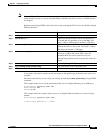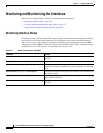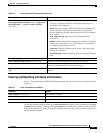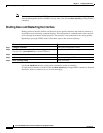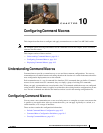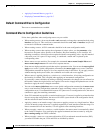
9-24
Cisco ME 3400 Ethernet Access Switch Software Configuration Guide
OL-9639-06
Chapter 9 Configuring Interfaces
Configuring the System MTU
frames on all Gigabit Ethernet interfaces by using the system mtu jumbo global configuration
command. You can change the MTU size for routed ports by using the system mtu routing global
configuration command.
Note You cannot configure a routing MTU size that exceeds the system MTU size. If you change the system
MTU size to a value smaller than the currently configured routing MTU size, the configuration change
is accepted, but not applied until the next switch reset. When the configuration change takes effect, the
routing MTU size automatically defaults to the new system MTU size.
Gigabit Ethernet ports are not affected by the system mtu command. Fast Ethernet ports are not affected
by the system mtu jumbo command because jumbo frames are not supported on 10/100 interfaces,
including 100BASE-FX and 100BASE-BX SFP modules. If you do not configure the system mtu jumbo
command, the setting of the system mtu command applies to all Gigabit Ethernet interfaces.
You cannot set the MTU size for an individual interface; you set it for all 10/100 or all Gigabit Ethernet
interfaces on the switch. When you change the system MTU size, you must reset the switch before the
new configuration takes effect. The system mtu routing command does not require a switch reset to take
effect.
Note The system MTU setting is saved in the switch environmental variable in NVRAM and becomes
effective when the switch reloads. Unlike the system MTU routing configuration, the MTU settings you
enter with the system mtu and system mtu jumbo commands are not saved in the switch IOS
configuration file, even if you enter the copy running-config startup-config privileged EXEC
command. Therefore, if you use TFTP to configure a new switch by using a backup configuration file
and want the system MTU to be other than the default, you must explicitly configure the system mtu
and system mtu jumbo settings on the new switch and then reload the switch.
Frames sizes that can be received by the switch CPU are limited to 1998 bytes, no matter what value was
entered with the system mtu or system mtu jumbo commands. Although frames that are forwarded or
routed are typically not received by the CPU, in some cases packets are sent to the CPU, such as traffic
sent to control traffic, SNMP, Telnet, or routing protocols.
Because the switch does not fragment packets, it drops:
• switched packets larger than the packet size supported on the egress interface
• routed packets larger than the routing MTU value
For example, if the system mtu value is 1998 bytes and the system mtu jumbo value is 5000 bytes,
packets up to 5000 bytes can be received on interfaces operating at 1000 Mbps. However, although a
packet larger than 1998 bytes can be received on an interface operating at 1000 Mbps, if its destination
interface is operating at 10 or 100 Mbps, the packet is dropped.
Routed packets are subjected to MTU checks on the sending ports. The MTU value used for routed ports
is derived from the configured system mtu value (not the system mtu jumbo value). That is, the routed
MTU is never greater than the system MTU for any VLAN. The routing protocols use the system MTU
value when negotiating adjacencies and the MTU of the link. For example, the Open Shortest Path First
(OSPF) protocol uses this MTU value before setting up an adjacency with a peer router. To view the
MTU value for routed packets for a specific VLAN, use the show platform port-asic mvid privileged
EXEC command.



